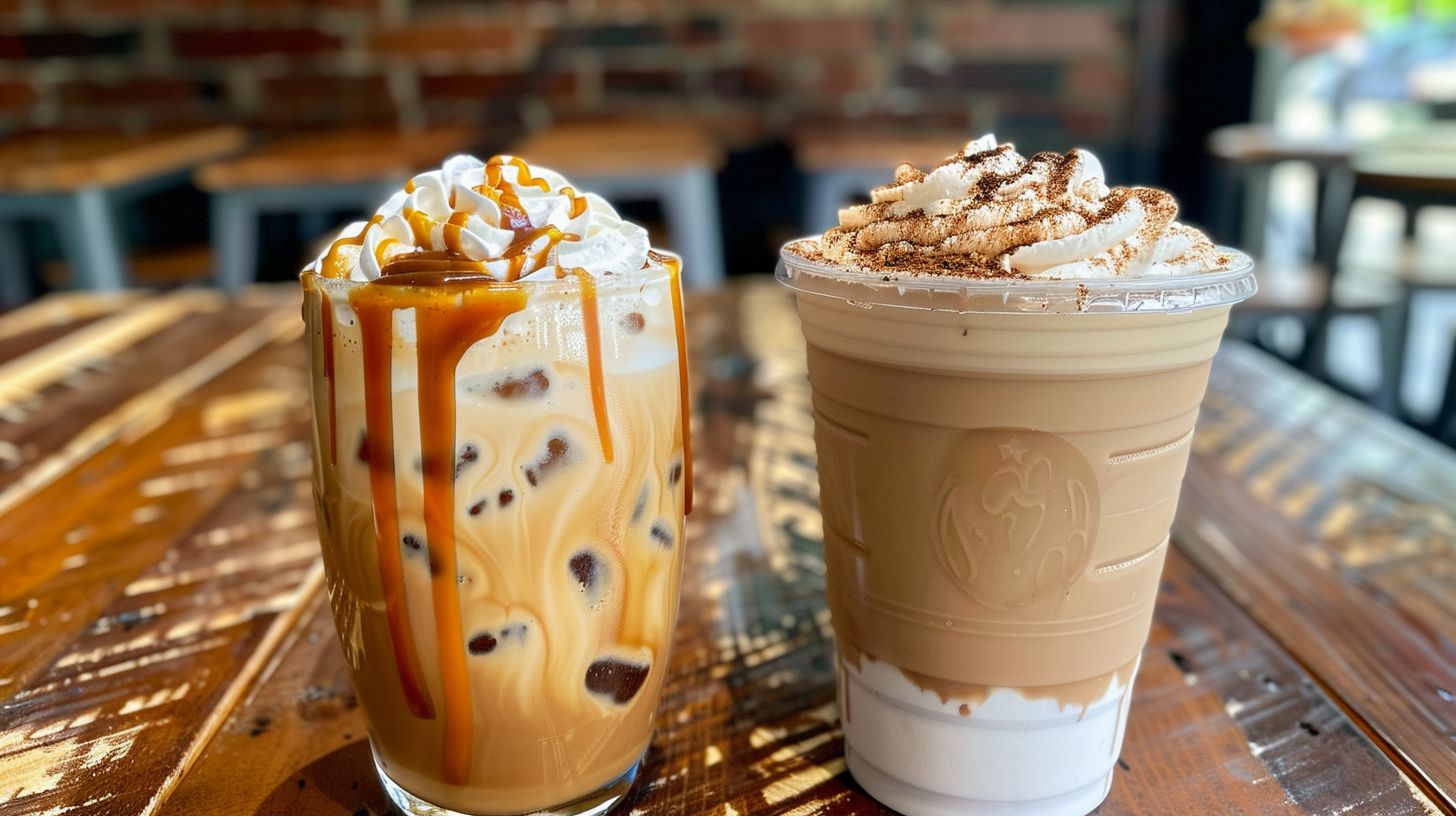Caramel Macchiato Vs Vanilla Latte: The Ultimate Comparison Of Iced Varieties
Caramel macchiatos and vanilla lattes often confuse customers at coffee counters because both drinks include espresso, milk, and flavoured syrup. Despite their shared ingredients, they deliver distinct flavour experiences due to differences in assembly and proportion.
A caramel macchiato builds its flavour through layering, which places espresso above milk and syrup and results in a stronger initial coffee taste. A vanilla latte mixes ingredients from the start, which produces a smoother and sweeter profile with consistent taste throughout.
The way each drink is constructed changes the balance between espresso and sweetness, which affects both taste and texture. This article compares them side by side to help you understand what makes each drink unique and how those differences shape your drinking experience.
At-A-Glance Comparison
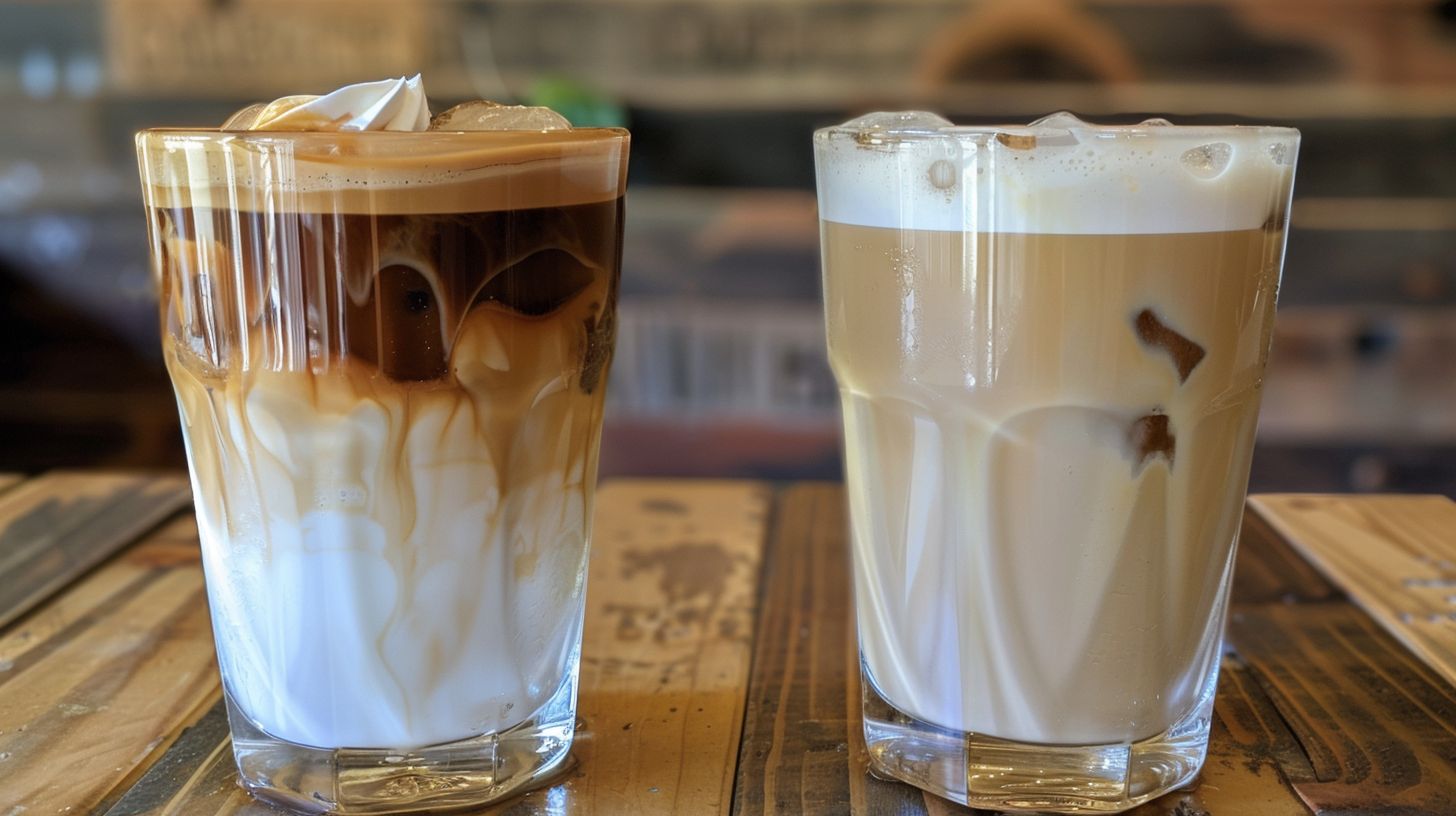
Caramel macchiatos and vanilla lattes differ in strength, sweetness, and structure. These differences emerge from how ingredients are arranged and how much milk is used. Macchiatos layer components, which separates flavours and places espresso on top. Lattes blend everything, which creates a uniform taste and texture from the first sip.
The espresso-to-milk ratio shifts the flavour profile in each drink. A higher espresso concentration produces intensity, while more milk results in mildness and creaminess.
Key Differences Overview
| Feature | Caramel Macchiato | Vanilla Latte |
|---|---|---|
| Espresso shots | Typically 2 | Usually 1 |
| Milk ratio | Lower milk content | Higher milk volume |
| Sweetener | Vanilla syrup (bottom) + caramel top | Vanilla syrup (blended throughout) |
| Preparation | Layered with espresso last | Blended with espresso first |
| Flavour strength | Bold and coffee-forward | Smooth and sweet |
| Texture | Light with layered mouthfeel | Creamy and consistent |
| Visual appearance | Distinct layers | Uniform colour |
Summary Of Effects
- Higher espresso concentration in macchiatos intensifies flavour, which appeals to bold coffee drinkers.
- Increased milk volume in lattes softens the drink, which suits those seeking balance and sweetness.
- Layered structure in macchiatos delivers a flavour shift during drinking, which adds contrast between sips.
- Fully blended lattes keep flavour even throughout, which creates a predictable and smooth experience.
These differences reflect how structure and ratio determine the drink’s outcome. Understanding them allows you to choose based on flavour intensity, texture, and sweetness preference.
Core Ingredients And Preparation
Both drinks rely on espresso, milk, and syrup, yet their order of assembly and volume ratios differ. These differences reshape the flavour experience because ingredient placement determines how each component interacts on the palate.
A caramel macchiato layers milk first, syrup second, and espresso last, which produces a top-heavy coffee impact followed by a sweet finish. A vanilla latte combines espresso and syrup with milk from the start, which distributes sweetness evenly and softens espresso bitterness.
The preparation method alters mouthfeel and sweetness perception because layering delays ingredient integration while blending promotes uniformity.
Caramel Macchiato Preparation
- Espresso: 1 or 2 shots poured last to sit above milk
- Milk: Cold or steamed, added first
- Syrup: Vanilla, placed at the bottom
- Topping: Caramel drizzle over espresso
This structure creates visual contrast and layered flavour, which shifts with each sip from espresso to caramel.
Vanilla Latte Preparation
- Espresso: Pulled first, then combined with milk
- Milk: Steamed or iced, blended with espresso
- Syrup: Vanilla, mixed evenly with other ingredients
- Topping: Usually none, but can be customised
Blending all components ensures a balanced flavour from beginning to end, which suits those who prefer a consistent taste.
Ingredient Comparison Table
| Component | Caramel Macchiato | Vanilla Latte |
|---|---|---|
| Espresso | Poured over milk and syrup | Blended into milk and syrup |
| Milk | Lower ratio, added first | Higher volume, combined fully |
| Sweetener | Vanilla syrup at base, caramel top | Vanilla syrup blended throughout |
| Texture | Light, layered | Creamy, smooth |
The ingredient order directly impacts strength, sweetness, and finish. Each drink appeals to a different preference due to how its components interact during consumption.
Flavour Profiles And Texture
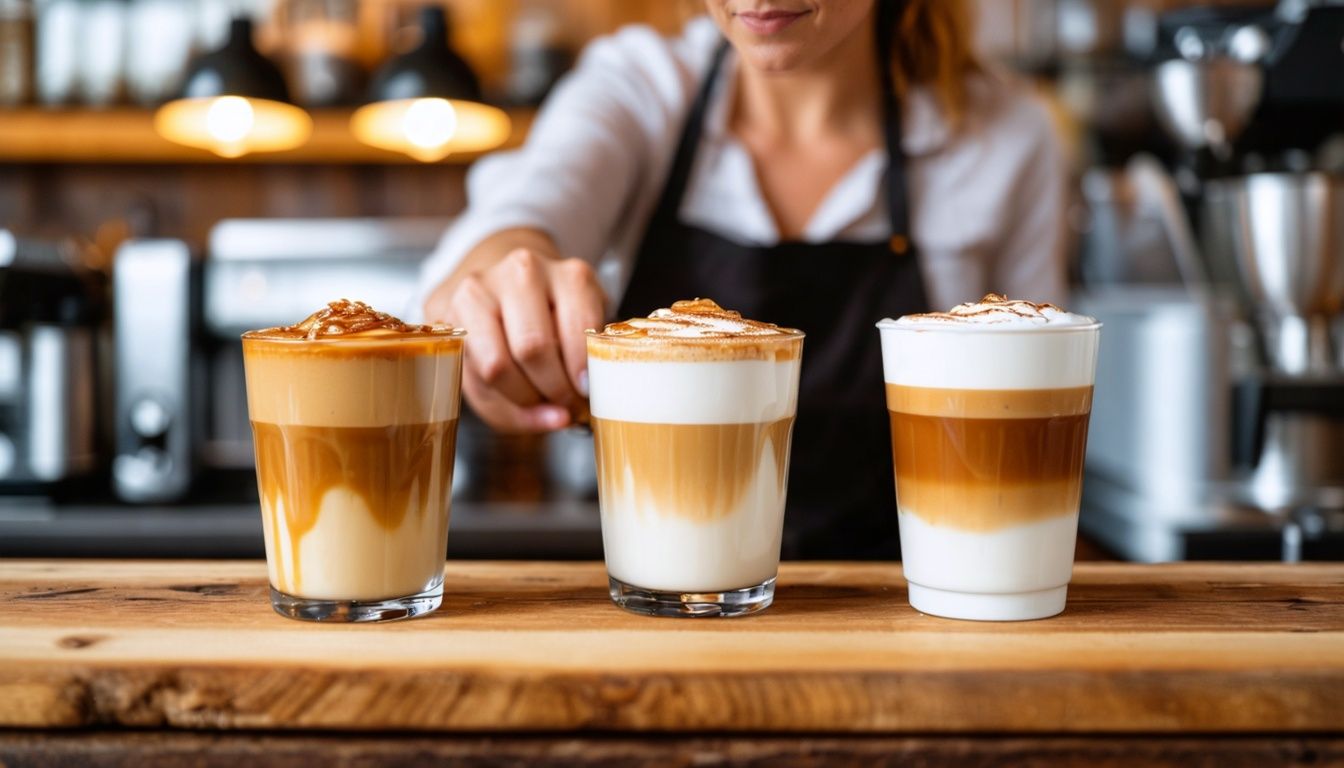
Flavour and texture differ between these two drinks due to variations in milk quantity, syrup blending, and espresso concentration. Caramel macchiatos emphasise coffee flavour upfront, which occurs because espresso sits above the milk and syrup. Vanilla lattes provide a mellow experience, which results from even ingredient distribution throughout the cup.
Espresso layering in a macchiato sharpens the first few sips, which tapers off into sweetness as caramel and milk take over. Lattes balance flavour from start to finish, which appeals to drinkers seeking consistency.
Key Flavour Characteristics
| Attribute | Caramel Macchiato | Vanilla Latte |
|---|---|---|
| Initial taste | Strong espresso | Smooth vanilla-milk blend |
| Sweetness | Mild at first, stronger later | Even and sustained |
| Body | Light to medium | Medium to heavy |
| Aftertaste | Caramel finish | Subtle vanilla tone |
Texture And Mouthfeel
- Macchiatos have a thinner body because they contain less milk.
- Lattes feel creamier since milk volume is greater.
- Layering introduces flavour shifts during the drink, which enhances contrast.
- Blending produces uniform texture, which delivers predictable mouthfeel.
These distinctions shape how each drink is perceived. Those who enjoy dynamic contrast may favour the macchiato, while those who value balance tend to prefer the latte.
Nutritional Comparison
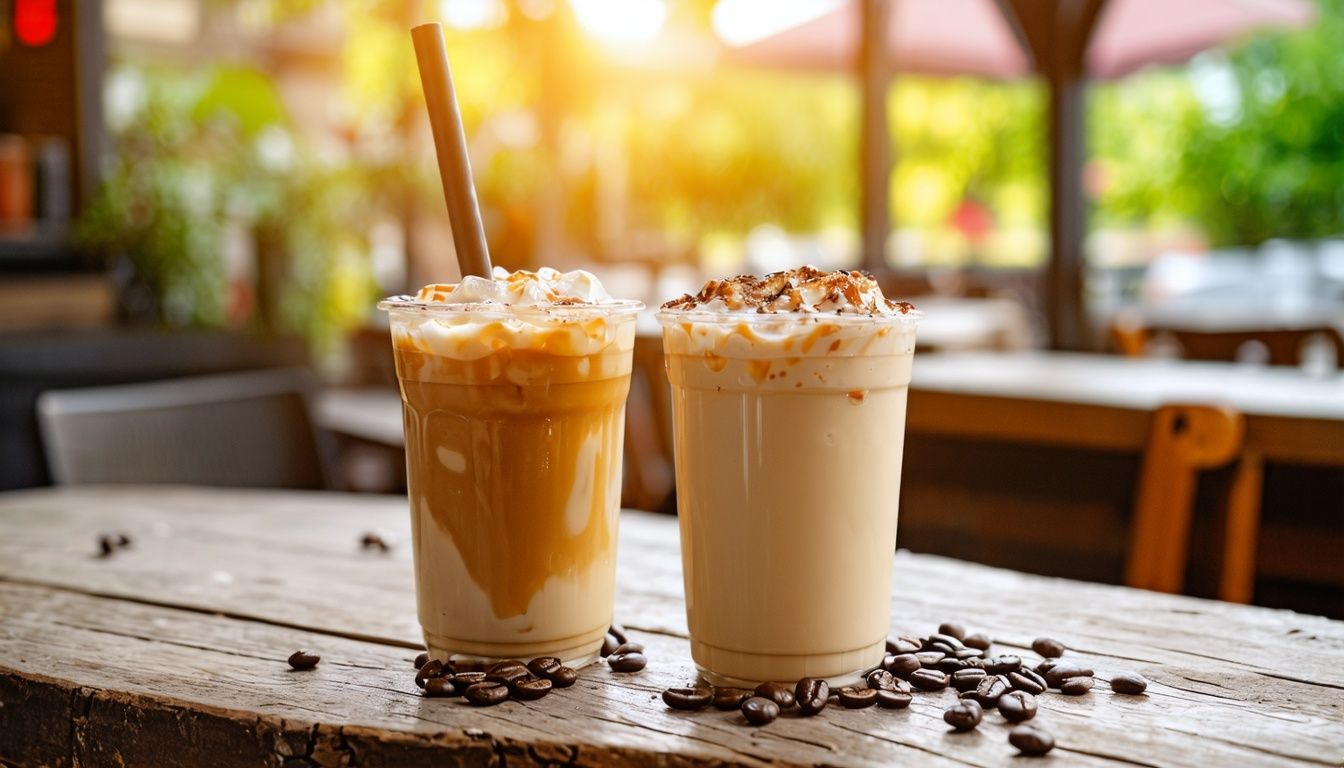
Nutritional values differ between caramel macchiatos and vanilla lattes due to their espresso count, milk volume, and syrup concentration. Macchiatos often contain fewer calories because they use less milk, while lattes tend to have more fat and sugar, which results from a higher dairy and syrup ratio.
The caffeine content also shifts between drinks. A standard macchiato uses two espresso shots, which increases its caffeine load compared to a latte with one shot. This difference makes the macchiato more appealing to those who prioritise energy over sweetness.
Standard Nutritional Values (12 oz serving)
| Nutrient | Caramel Macchiato | Vanilla Latte |
|---|---|---|
| Calories | Approx. 190 | Approx. 210 |
| Total fat | 4g | 5–7g depending on milk used |
| Sugar | 22g | 25–28g |
| Protein | 6–7g | 7–9g |
| Caffeine | 150mg (double shot) | 75mg (single shot) |
Factors That Influence Nutritional Content
- Milk type affects fat and calorie count, which changes the drink’s density and satiety.
- Syrup volume adjusts sugar levels, which can increase sweetness or reduce total calories.
- Espresso quantity alters caffeine strength, which makes the drink more or less energising.
- Toppings like caramel drizzle or whipped cream raise sugar and fat totals, which may impact dietary goals.
Each drink offers flexibility depending on how it’s prepared. Small modifications in milk or syrup quantity can significantly adjust nutrition, making either drink suitable for different health preferences.
Customisation Options

Caramel macchiatos and vanilla lattes are highly adaptable drinks because coffee shops offer multiple ways to adjust ingredients and ratios. These customisations allow customers to tailor flavour, strength, and nutrition, which increases the drink’s suitability across different preferences.
Altering milk types changes texture and calorie count, which influences mouthfeel and dietary compatibility. Adjusting syrup quantity impacts sweetness, which makes the drink lighter or richer depending on user intent.
Ways To Customise Your Drink
- Swap whole milk for oat, almond, or soy milk to reduce fat or introduce new textures.
- Reduce the number of syrup pumps to lower sugar content and moderate sweetness.
- Add an extra espresso shot to increase caffeine strength and balance sweetness.
- Use sugar-free syrup alternatives to maintain flavour while reducing overall calorie intake.
- Request no caramel drizzle in a macchiato to cut excess sugar and simplify the finish.
- Top with cinnamon, nutmeg, or cocoa powder to add complexity without additional calories.
Common Customisation Effects
| Adjustment | Resulting Change | Causal Reason |
|---|---|---|
| Oat milk | Creamier texture, slightly sweet | Higher carbohydrate and fat content |
| Extra espresso shot | Stronger taste, more caffeine | Greater concentration of coffee per volume |
| Sugar-free syrup | Less sweetness, fewer calories | Artificial or low-glycaemic sweetener used |
| Less syrup | Milder sweetness, more coffee-forward | Reduced flavouring preserves espresso dominance |
| Almond milk | Light texture, nutty finish | Low fat and neutral flavour enhance drink clarity |
These changes modify the drink’s character by shifting the balance between espresso, milk, and syrup. This control allows for dietary flexibility while maintaining the drink’s core identity.
Coffee Shop Offerings
Caramel macchiatos and vanilla lattes appear on most café menus because their core ingredients appeal to a wide range of coffee drinkers. Both drinks remain popular year-round, which reflects their flexibility and familiarity in commercial settings.
Coffee chains prepare each drink using standard methods, which ensures consistency in flavour and appearance across locations. Layering techniques in macchiatos create visual appeal, while full integration in lattes provides a predictable flavour profile that many customers prefer.
Standard Menu Composition
- Caramel macchiatos are made with vanilla syrup, cold or steamed milk, espresso poured over the top, and a caramel drizzle. This format separates flavours, which adds contrast throughout the drink.
- Vanilla lattes combine vanilla syrup, espresso, and milk in a single blend. This approach produces uniform sweetness, which appeals to those who value consistency.
Typical Variations By Café
| Drink Type | Common Modifications | Causal Result |
|---|---|---|
| Caramel macchiato | Extra drizzle, alternative milk, iced | Adjusts sweetness and texture based on preference |
| Vanilla latte | Decaf option, flavoured foam, iced version | Reduces caffeine or adds aroma without sugar |
Customer-Focused Adjustments
- Baristas often offer syrup alternatives to support sugar reduction, which meets dietary goals without eliminating flavour.
- Temperature options like iced or hot versions extend drink usability, which increases their relevance across seasons.
- Milk customisation remains a top request, which influences texture and alters nutritional content.
These offerings maintain relevance in busy cafés by accommodating diverse customer preferences. By standardising the base recipe while allowing customisation, shops balance consistency with flexibility.
Comparison With Other Iced Coffee Drinks
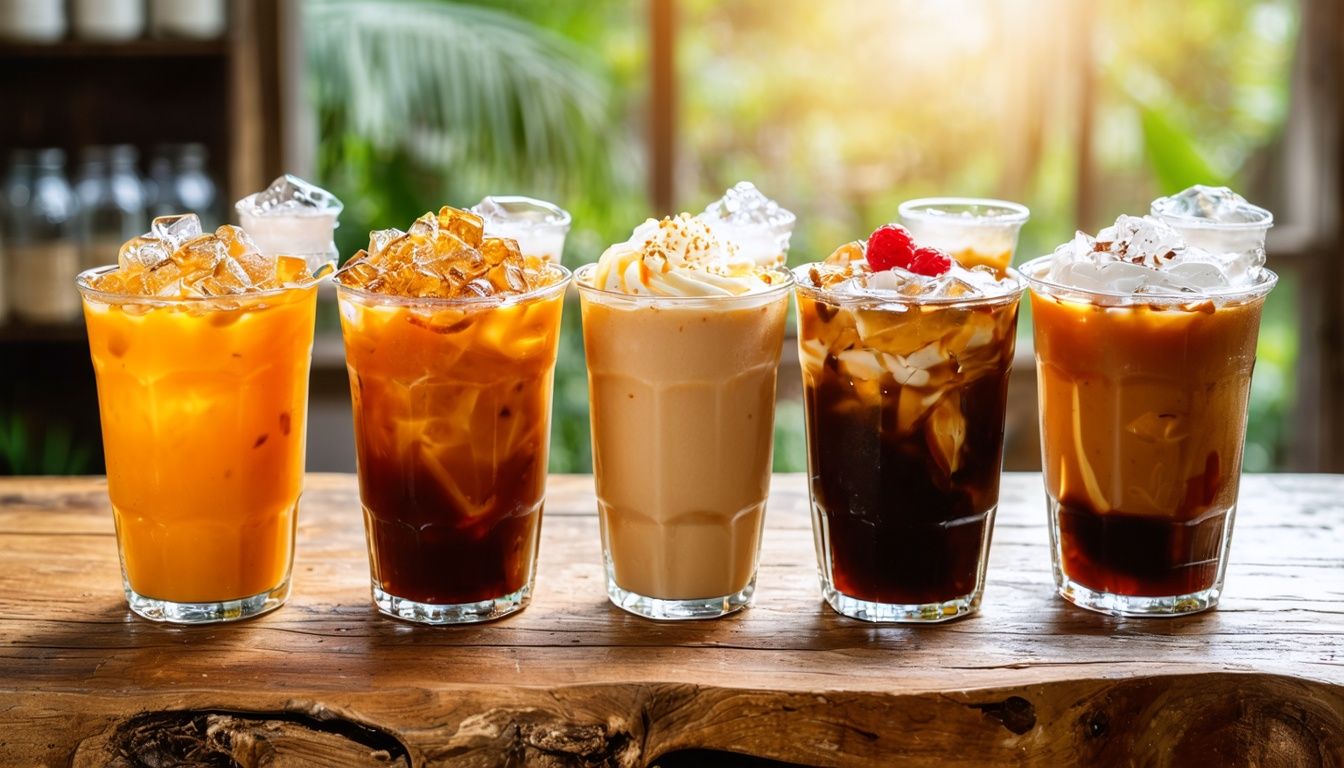
Caramel macchiatos and vanilla lattes stand out among iced coffee drinks because their flavour structure depends on milk integration and syrup positioning. Other iced drinks differ in preparation, which influences body, bitterness, and clarity.
Cold brew develops flavour through slow steeping, which reduces acidity and enhances smoothness. Iced Americanos dilute espresso with water, which increases sharpness and minimises body. These differences offer contrast in strength and flavour clarity compared to milk-based drinks.
Comparative Overview
| Drink Type | Key Ingredients | Causal Effect On Flavour |
|---|---|---|
| Caramel macchiato | Milk, vanilla syrup, espresso, caramel | Strong espresso at the top with sweet finish |
| Vanilla latte | Milk, vanilla syrup, espresso | Smooth, consistent vanilla flavour |
| Cold brew | Ground coffee steeped in cold water | Mellow taste with reduced acidity |
| Iced Americano | Espresso diluted with water | Bold flavour, less body, more bitterness |
Key Differences In Structure And Taste
- Cold brews feel lighter due to the absence of milk, which reduces richness and enhances brightness.
- Americanos highlight espresso bitterness because water dilution preserves its intensity without softening.
- Macchiatos deliver flavour in stages, which results from layered assembly.
- Lattes maintain one flavour throughout, which stems from full integration of milk and syrup.
These comparisons reveal how milk and method control mouthfeel and flavour impact. When choosing an iced coffee, consider whether you prefer contrast, consistency, or clarity to match your taste expectations.
Customer Preferences And Real Experiences
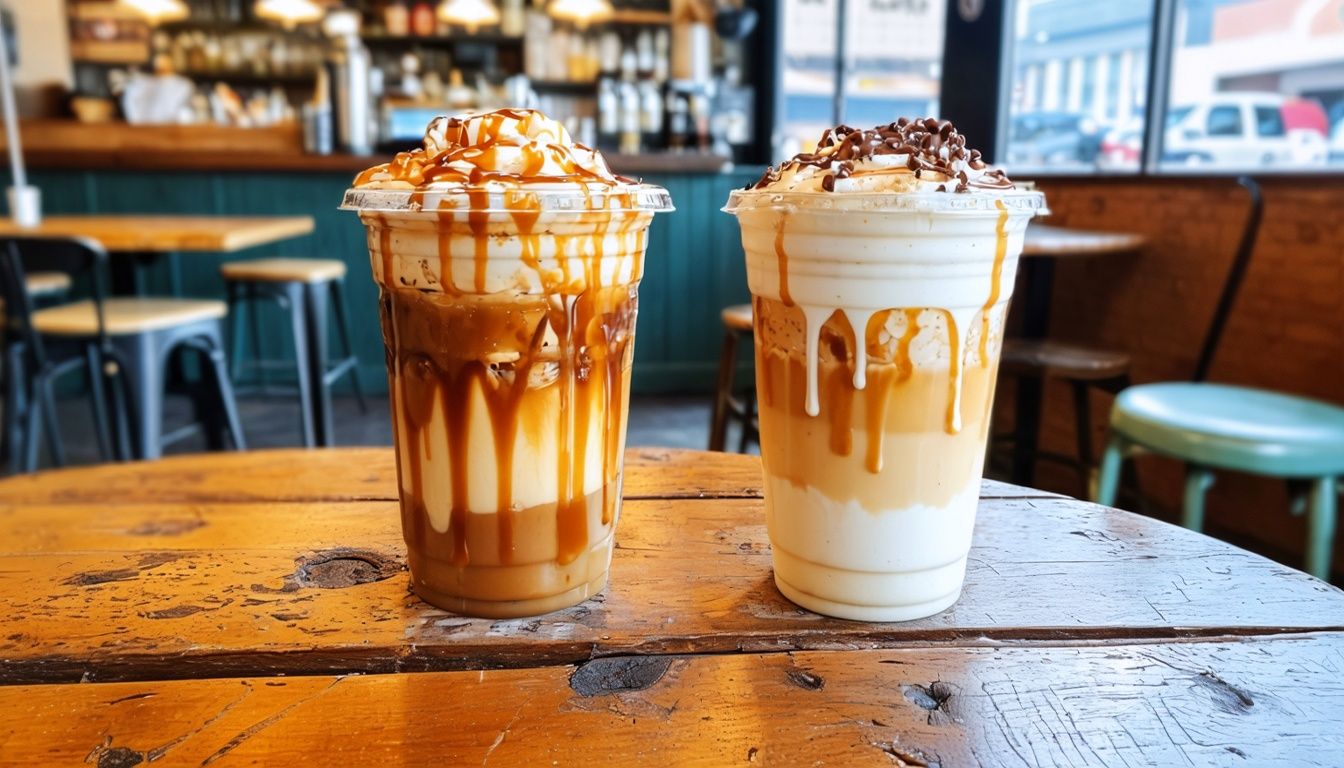
Customer choices reflect individual taste preferences, which vary based on texture, flavour strength, and sweetness. Caramel macchiato fans often select it for its bold top layer, which provides a strong espresso hit before mellowing into caramel. Vanilla latte drinkers prefer its smooth profile, which stays consistent from the first sip to the last.
Brand influence shapes perceptions, as major coffee chains like Starbucks introduced caramel macchiatos with signature presentation. This layered look draws attention, which encourages trial and reinforces preference.
Feedback from regular buyers reveals that ingredient balance and flexibility guide long-term loyalty. Texture, temperature, and sweetness all play a role in whether a drink becomes part of someone’s daily routine.
Common Reasons For Preference
- Macchiato drinkers report enjoying layered contrast, which creates flavour separation between espresso and syrup.
- Latte drinkers value uniform sweetness, which makes the drink easier to customise or pair with food.
- Visual appeal influences initial impressions, which encourages customers to post or share their drink choices.
- Customisation options increase satisfaction, which results from adapting milk types, syrup levels, or caffeine strength.
Observed Trends In Customer Behaviour
| Behaviour Type | Preference Outcome | Causal Reason |
|---|---|---|
| Daily buyers | More likely to order lattes | Lower caffeine and consistent taste suit routine |
| Seasonal buyers | Favour iced macchiatos in summer | Layered design and bold taste refresh quickly |
| Customisers | Prefer lattes with milk alternatives | Easier to blend plant milks without textural loss |
| First-time buyers | Choose lattes for approachability | Mild sweetness and low intensity feel accessible |
These trends show how drink structure and flavour delivery affect satisfaction. Whether chosen for routine or novelty, both drinks continue to meet varied expectations across a broad customer base.
Storage And Freshness Tips
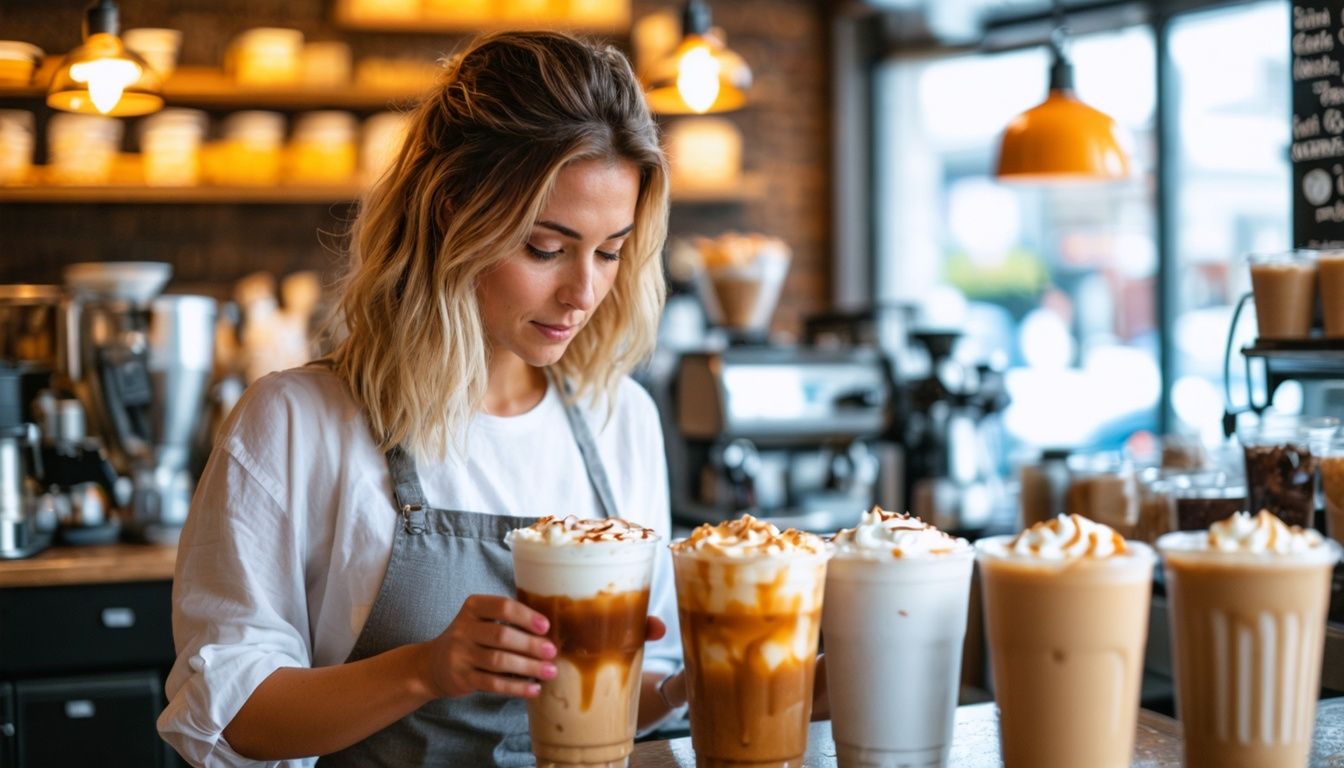
Drink freshness depends on ingredient handling and storage conditions, which influence flavour quality over time. Syrups, milk, and espresso each have unique storage requirements, which affect how long a caramel macchiato or vanilla latte maintains its intended taste and texture.
Cold milk retains its smooth texture when kept below 4°C, which slows bacterial growth and prevents sourness. Flavoured syrups remain stable at room temperature, provided they are sealed tightly, which limits oxidation and maintains sweetness. Brewed espresso loses aroma within minutes, which makes immediate consumption important for optimal flavour.
Storage Guidelines For Key Components
| Ingredient | Ideal Storage Method | Causal Outcome |
|---|---|---|
| Milk | Refrigerated at 1–4°C | Preserves freshness and prevents bacterial growth |
| Syrup | Room temperature in sealed bottle | Avoids air exposure, which maintains flavour |
| Espresso | Freshly brewed, not stored | Maximises aroma and avoids bitterness |
| Prepared drink | Airtight container, refrigerated | Maintains drink structure for a short period |
Tips For Maintaining Drink Quality
- Store syrups away from heat and light, which helps retain flavour concentration.
- Avoid reheating espresso, which introduces bitterness due to compound breakdown.
- Use insulated containers for iced versions, which prevents dilution and texture loss.
- Limit storage time to under 24 hours, which reduces the risk of flavour separation or spoilage.
- Shake or stir before consuming stored drinks, which recombines layers and restores mouthfeel.
Proper storage extends drink quality by controlling degradation of texture and flavour. Following basic temperature and handling practices ensures each cup remains close to its original profile.
Conclusion
Caramel macchiatos and vanilla lattes serve different flavour expectations because their ingredients are combined using distinct methods. Macchiatos layer espresso on top, which creates a stronger opening and a caramel-sweet finish. Lattes blend all components evenly, which results in a smoother, consistent flavour.
Milk ratio, syrup placement, and espresso quantity define the sensory experience of each drink. These variables affect taste strength, texture, and sweetness, which makes one option better suited depending on personal preference.
Choosing the right drink depends on what you value—contrast or consistency, boldness or balance. By understanding how structure shapes flavour, you can order more confidently and customise more precisely.
FAQs
Questions about caramel macchiatos and vanilla lattes often arise due to their similar ingredients but differing flavour outcomes. Each answer below clarifies common points of confusion, which helps improve decision-making and ordering accuracy.
What Is The Main Difference Between A Caramel Macchiato And A Vanilla Latte?
The caramel macchiato layers espresso over milk and syrup, which intensifies the coffee flavour at the top. The vanilla latte blends all ingredients, which produces a smoother, unified taste.
Which Drink Has More Caffeine?
Caramel macchiatos typically use two espresso shots, which increases the caffeine content. Vanilla lattes often contain one shot, which reduces total caffeine by comparison.
Can I Make These Drinks With Plant-Based Milk?
Yes. Oat, almond, and soy milks are all compatible with both drinks. Each type changes texture and flavour because of its unique fat and protein composition.
Which Drink Is Sweeter?
Vanilla lattes generally taste sweeter throughout due to uniform syrup distribution. Caramel macchiatos start less sweet and become richer near the end, which results from syrup and drizzle placement.
Are These Drinks Available Iced And Hot?
Yes. Both drinks can be served iced or hot, which makes them adaptable to seasonal preferences and temperature needs.
Can I Reduce The Sugar Content?
Yes. You can ask for fewer syrup pumps or switch to sugar-free alternatives, which significantly lowers sweetness without removing core flavours.
